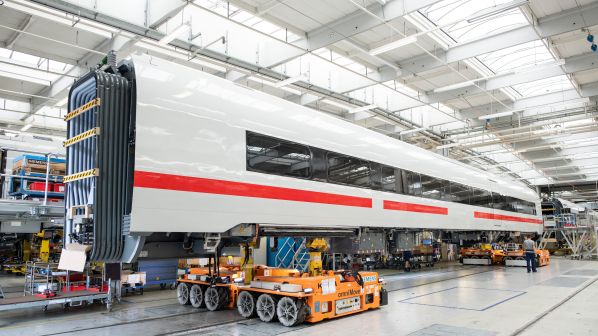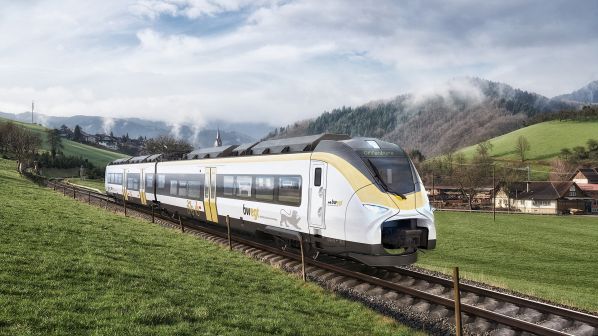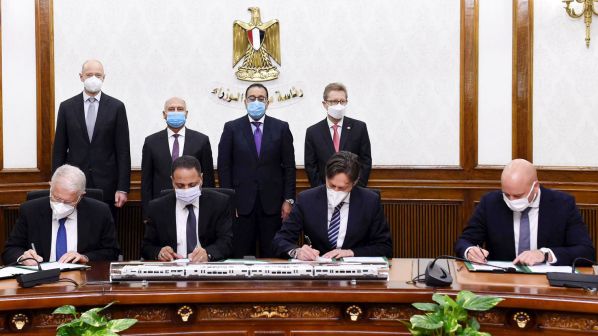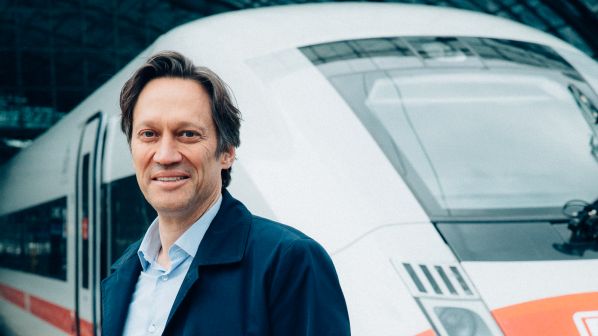SIEMENS Mobility confirmed that it had completed a deal to acquire Netherlands-based Sqills on October 5. The €550m transaction bolsters Siemens’ capabilities in cloud-based inventory management and reservation and ticketing software, and complements the 2017 acquisition of HaCon, Germany, an international provider of planning, scheduling and information systems.
The deal is reflective of Siemens Mobility’s wider market strategy, which emphasises technological leadership and digitalisation. A decade ago, CEO Mr Michael Peter says the supplier was focused on selling trains, interlockings, signalling and operational control systems - single systems - it was not, as he puts it, “the SAP” for rail. However, digitalisation is changing the market and in turn Siemens. Peter says the supplier is now able to offer its customers Software as a Service (SaaS) solutions alongside its traditional hardware to facilitate a smart, integrated and seamless transport experience.
For Peter, this approach presents an obvious solution to what he says is a major area of untapped potential for rail: its relatively poor asset utilisation rate. He says German Rail (DB) pre-Covid had a utilisation rate of 65%. “For metros it is even lower, 25%,” Peter says. “They are packed for just two hours of the day. And yet we’re still asking how can we carry twice as many people in 2030?
“It is possible, we will need better and more reliable trains, reduced energy consumption and an increase in capacity, especially where there are bottlenecks, but the big untapped potential is the utilisation rate.”
Harnessing passenger usage data and an increase in flexible working in the post-Covid world potentially offers the perfect recipe for operators to close this gap. Peter says spreading demand could transform subsidised metros into profitable businesses. This could mean extra money is available to build new lines, attracting even more people away from their cars and onto public transport.
Similarly for main lines, having the flexibility to price tickets based on demand is an obvious way to attract new passengers to boost off-peak utilisation. It’s an area where some airlines excel - Ryanair had an occupancy rate of 95% pre-Covid. In general, though, rail currently fails to maximise these strategies, apart from some notable examples: Spain’s high-speed network has a similar model to aviation and has a 70% occupancy rate. It’s a similar situation with the TGV network in France while Germany’s standard interval timetable could potentially address the issue by optimising connections.
“From the moment someone starts looking for a ticket, we can make rail the most attractive piece in the middle of the journey.”
Recent announcements of nationwide Mobility as a Service (MaaS) projects in Spain and the Netherlands, which Siemens will deliver via HaCon and local partners, are also encouraging. Crucially, operators here have agreed to make data and pricing transparent and to allow cross selling, overcoming a traditional barrier to progress with MaaS in other European markets.
Peter says Siemens can help these operators by providing a truly integrated offer. Many of the technologies have existed for a few years but often are tailor-made solutions built by in-house IT departments that do not work very well together. As companies have attempted to transition these systems to other networks, Peter says they found that the algorithms did not work effectively because customers in other countries often have different behaviours while the operators have different ideas of how to run the railway.
French National Railways (SNCF) is one such example where an attempt to transition what had worked in France to international contracts was unsuccessful. The company subsequently tasked Sqills to come up with a new system for Eurostar, and this has since been extended to Ouigo and Ouigo Spain, and in the future the entire SNCF passnger network.

“I do think that offering a consistent software chain is a big opportunity,” Peter says. “From the moment someone starts looking for a ticket, we can make rail the most attractive piece in the middle of the journey. We can look for the first and last mile connections and sell additional services. HaCon also has the ability to know when a train is delayed and to send an SMS to the passenger to say your train is delayed and that we have booked you on another connection. The operator could optimise this and offer a specific service, prioritising the allocation of seats depending on a platinum, gold or silver status, helping to drastically improve the service for passengers.”
Siemens’ emphasis on technological leadership is reinforced by consistently high levels of research and development spending. Peter says of the company’s achievements during the pandemic-affected period of the last 18 months, sticking to the strategy and maintaining R&D spending levels at €400m is the area he is most proud of. He is also pleased that the company remained profitable, and after reporting orders of €9.169bn in 2019-20, did not reduce its significant order backlog of €32bn, of which €8bn was expected to convert into revenue in 2020-21.
Overall, Peter says the book to bill order intake rate was slightly above one last year. “We are used to a book to bill ratio of 1.2, 1.3, so yes we did feel coronavirus, but on the other hand we did not eat into our backlog,” Peter says. “We are growing faster than the market and we want to continue to bring orders in that align with our strategy and portfolio.”
Market position
Siemens’ position in the market was confirmed in the latest analysis of the rolling stock market published last month by German consultancy, SCI Verkehr. With annual revenues of €9.052bn, Siemens swapped positions with Transmashholding to occupy fourth spot. In reality, this is now third position behind Alstom after the French manufacturer, which is placed second in the study, confirmed its acquisition of third-placed Bombardier at the end of January 2021. CRRC, though, remains well out in front.
Alstom’s decision to acquire Bombardier Transportation followed an unsuccessful merger attempt with Siemens. The deal was announced in September 2017 but was blocked in February 2019 by the European Commission (EC). The EC said the two companies failed to address its concerns about the impact their tie-up would have on competition in European high-speed and signalling markets.
For Peter, the Alstom-Bombardier merger only reinforces Siemens’ strategy to invest in technology and grow faster than the market. Removing a competitor could also boost Siemens’ chances of winning contracts. After all, combining two companies of this scale is a complicated undertaking; both companies possess a locomotive range and a locomotive factory and Peter says the only efficiency gains are found if you secure two-times the volume with one locomotive range and one factory. “We all still only have one customer and in public bidding, you can only put in one bid,” Peter says.
“As long as my locomotive is better than the other two, I couldn’t care less. Any consolidation is good for me. What is most important to us is that we have the best locomotive.”
Peter also distanced Siemens from a similar scale merger in the future, stating that he didn’t think there is another partner that would “get us forward” and that it is not the company’s “focus right now.” He cited the difficulties Siemens would have due to its leadership in key areas of the market. “This was the problem with Alstom-Siemens, they were both too strong,” he says.
“As long as my locomotive is better than the other two, I couldn’t care less. Any consolidation is good for me. What is most important to us is that we have the best locomotive.”
Alstom’s rationale for pursuing the Bombardier merger was to secure a stronger foothold in the global market. When asked whether Siemens can compete effectively on a global scale, Peter responds with one word: “Egypt.”
Siemens and its consortium partners Orascom Construction and The Arab Contractors inked a €4.5bn contract with Egypt’s National Authority for Tunnels (NAT) on September 1 to build the first 660km phase of a 1800km network that will connect the Red Sea with the Mediterranean coast. Siemens’ has a €3bn share of the contract. Additional contracts for the remaining two phases are expected to be signed imminently (see panel below).
Other recent notable successes include the United States where Siemens secured a $US 3.4bn contract from Amtrak to supply 73 trains in July. The order consists of 50 dual mode diesel-electric push-pull trains, 15 battery electric hybrid trains and eight diesel locomotive-hauled coaches. Peter says the deal shows that the Biden administration is willing to “put its money where its mouth is” when it comes to passenger rail investment. He is also optimistic about future opportunities that might emerge if the administration’s flagship Infrastructure Bill finally makes it through Congress.
While Siemens will supply rolling stock to Egypt from its German factories, it will do so in the United States from its established base in Sacramento. It will also fulfil contracts in Britain from a new factory in Goole. However, while respecting local procurement rules, Peter is cautious about committing to building new local factories to secure a single contract. He adds that Siemens is focusing its production strategy on vehicle platforms and that it has a single site for the production of high-speed trains at Krefeld, locomotives in Allach/Munich and urban rail vehicles in Vienna.
“When you have a platform vehicle you can focus on standardising the subcomponents and sourcing these from lead-cost countries,” Peter says.

Peter says the deployment of a national ETCS cloud-based digital interlocking will enable the removal of thousands of trackside huts which house relays and conventional interlockings, resulting in substantial reductions in costs for infrastructure managers. Germany still has 2600 interlocking buildings that use “hundreds of different technologies” and Peter says Siemens still produces relays designed in the 1930s for some of these. Norway is a testbed for this “one country, one interlocking” approach where Siemens is working with Bane Nor to deliver the trackside element of its ERTMS programme, which will deliver universal ETCS Level 2 deployment across the 4200km network by 2034. Siemens will deliver 4200 point machines, more than 7000 axle counters and 10,000 Eurobalises and Peter says all the infrastructure will be connected with a single IP protocol meaning it is possible to control a single point machine from a central hub in Oslo 1000km away.
“If I have a failure I can go to Oslo and I can fix it,” Peter says. “And with the data comparing 4000 point machines in the whole country, I know which point machine is starting to behave slightly differently compared with yesterday, so my predictability of behaviours is nearly 100%.”
Cloud-based interlockings will also be a feature of Siemens’ mainline automation offer. The first live S-Bahn application was demonstrated in Hamburg on October 11, which Peter says is a step forward from London’s Thameslink application, which went live in 2017. He says these installations, which are based on enhanced ATO and ETCS, have the potential to improve operational efficiency by 30%. They can also substantially improve maintenance practices. Thameslink trains are generating 9 million data points and 30% of the maintenance work orders are sourced directly from information provided by the train. “Our analysis shows that half of the delay minutes could be resolved just by knowing your data in the system and fixing it before it fails,” Peter says.
Alternative traction
Another industry trend in which Siemens is actively participating is the shift away from diesel to electric and alternative traction technologies in rail vehicles. Peter says there is a potential market in Europe for around 20,000 battery or hydrogen passenger trains. However, he says the greatest reduction in CO₂ could be found simply by installing a pantograph on diesel freight locomotives which for 60% of their time in service are operating beneath wires. “That’s the best sustainable investment you can ever do,” he says, adding that the Vectron multi-system locomotive, which offers a last mile diesel engine, is proving increasingly popular with customers.
Of course, it is not economic to electrify all lines. Peter says Siemens’ strategy for hydrogen and battery trains is not to reengineer a low-performance vehicle but to integrate it with its existing platforms, with the Mireo lightweight commuter train the testbed. Two hydrogen trains are currently on test with DB with line trials set to start next year, which will be a first for Siemens. Peter says as the supplier is joining the market in its second generation, it has been important to get the product right. He also foresees installation of a back-up battery onboard Siemens’ hydrogen trains to boost the efficiency of the hydrogen generator and improve acceleration.
“The result is that these trains are fully functional when they go into the city in mixed consists,” Peter says. “They have the full acceleration curve like you would on a commuter train and a hydrogen train has a range of 1000km. They have the full performance capability; it is not like a diesel bus on rails.”
The growing desire to explore these traction technologies reflects wider concerns for sustainability among governments around the world. While the Covid-19 pandemic still presents a “rollercoaster” for operators as passengers slowly return, which is a concern, Peter says governments armed with multi-billion stimulus packages are seeking to support investments that make a noticeable and lasting contribution and go beyond just “pouring concrete” as witnessed in past stimulus initiatives.
“People are saying that we need to invest in something that in five years we can look back and say that we’ve used that money to make a big step towards CO₂ neutrality,” Peter says.
While the US is potentially on the verge of passing a package that will allocate $US 60bn directly to rail, Peter says Europe’s spend is still ahead, which he says will translate into higher growth for Siemens by 2025 than was anticipated pre-pandemic. “We have a very positive outlook on the market,” he says.
Whether this spending is sufficient to ward off the looming threat of climate change remains up for debate. Peter says a recent study by McKinsey of transport in 25 global cities found that there is still a 30% gap in the funding required for countries to meet their sustainability targets by shifting more people to rail and public transport. Discussions between global leaders at this month’s COP26 event in Glasgow may yet produce an outcome that seeks to close this gap over the coming years. Such a scenario would present a potential boon to the rail supply industry, including Siemens, which seems well placed to benefit.
Egyptian high-speed project win a big statement for Siemens
THE $US 4.5bn contract is the first under a memorandum of understanding signed between Siemens and the National Authority for Tunnels (NAT) in January to design, build and equip Egypt’s first high-speed line, which Peter likens to a “Suez Canal on rails.” The first 460km phase will run between the developing cities of El-Alamein on the Mediterranean and Ai Sokhna on the Red Sea coast via the New Administrative Capital. A 200km phase two will extend the 250km/h line west from El Alamein to Marsa Matrouh.
Peter says the deal came around after a public tender for the project issued by NAT only solicited bids from two Chinese consortia, which NAT deemed as too expensive. He says there was also a feeling that the civil works could be carried out by local companies.
“We approached them at the end of last year and said look, why don’t we make a proposal to you for the technology portion, which is what we can do, but you take care of the civils, beneath the track, the bridges and the tunnels,” Peter says. “They liked this idea very much and cancelled the tender.”

$US 4.5bn contract with Egypt’s National Authority for Tunnels in the presence of the Egyptian prime minister and minister of transport, and the German Ambassador to Egypt on August 31.
Siemens will supply Velaro high-speed trains, Desiro regional trains and Vectron locomotives, all of which will be manufactured in Germany although the precise breakdown of the order has yet to be made public. It will also provide systems, including ETCS Level 2, power supply and communications along with system integration and maintenance. Peter says this will include the transfer of Artificial Intelligence and analytics technologies.
The operating concept combines both high-speed and commuter operation and envisages the operation of freight trains at night. Up to 30 million passengers per year will use the first section, while the second and third stages south to Luxor and Safaga are not expected to be as popular, and Peter says potentially fewer trains will be required here.
Peter adds that operation is set to be the responsibility of an international operating partner rather than Egyptian National Railway (ENR). “They have asked us for recommendations so we will work with them to pick an operator,” he says.
While energy production in Egypt does not entirely come from sustainable sources, the project is expected to contribute a 70% reduction in comparable CO₂ emissions. Peter also believes it will offer a new perception of the country. “Anyone travelling to Egypt and using these trains, whether you are a businessman or a tourist, is going to have quite a different experience from what they have today,” he says. “I think it is going to be transformative.”
As to whether this contract will stimulate similar transactions, Peter says the company has been approached by other countries interested in the concept. He says the fact that Siemens offers a train proven to operate in temperatures of up to 50˚C puts it in a strong position.
“There’s a lot of interest in how we have done this, especially from countries in North Africa and the Middle East,” Peter says. “I think the idea to go directly to suppliers to ask exactly what can be done is positive. It potentially makes a project like this a lot shorter and cheaper.”

